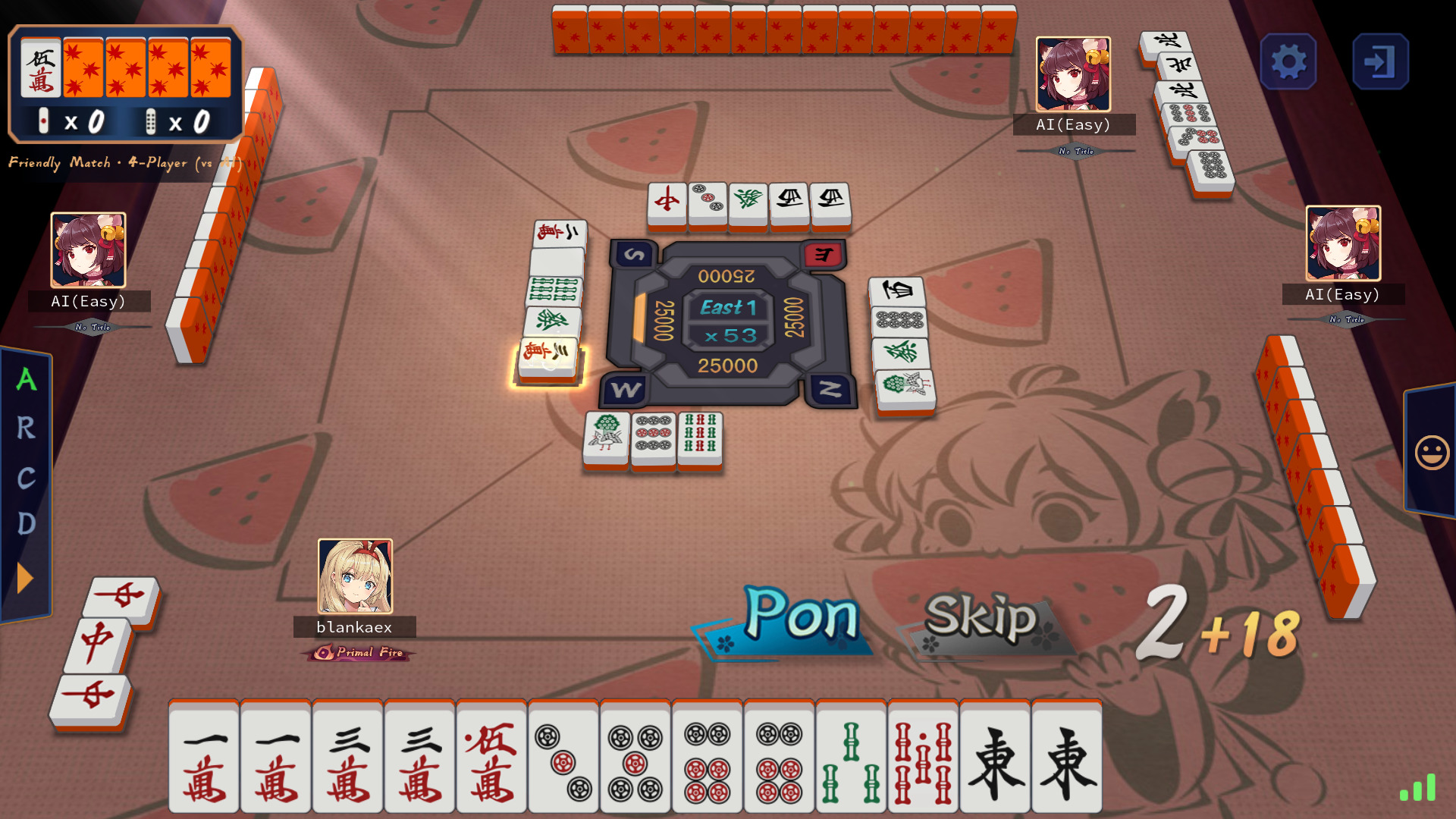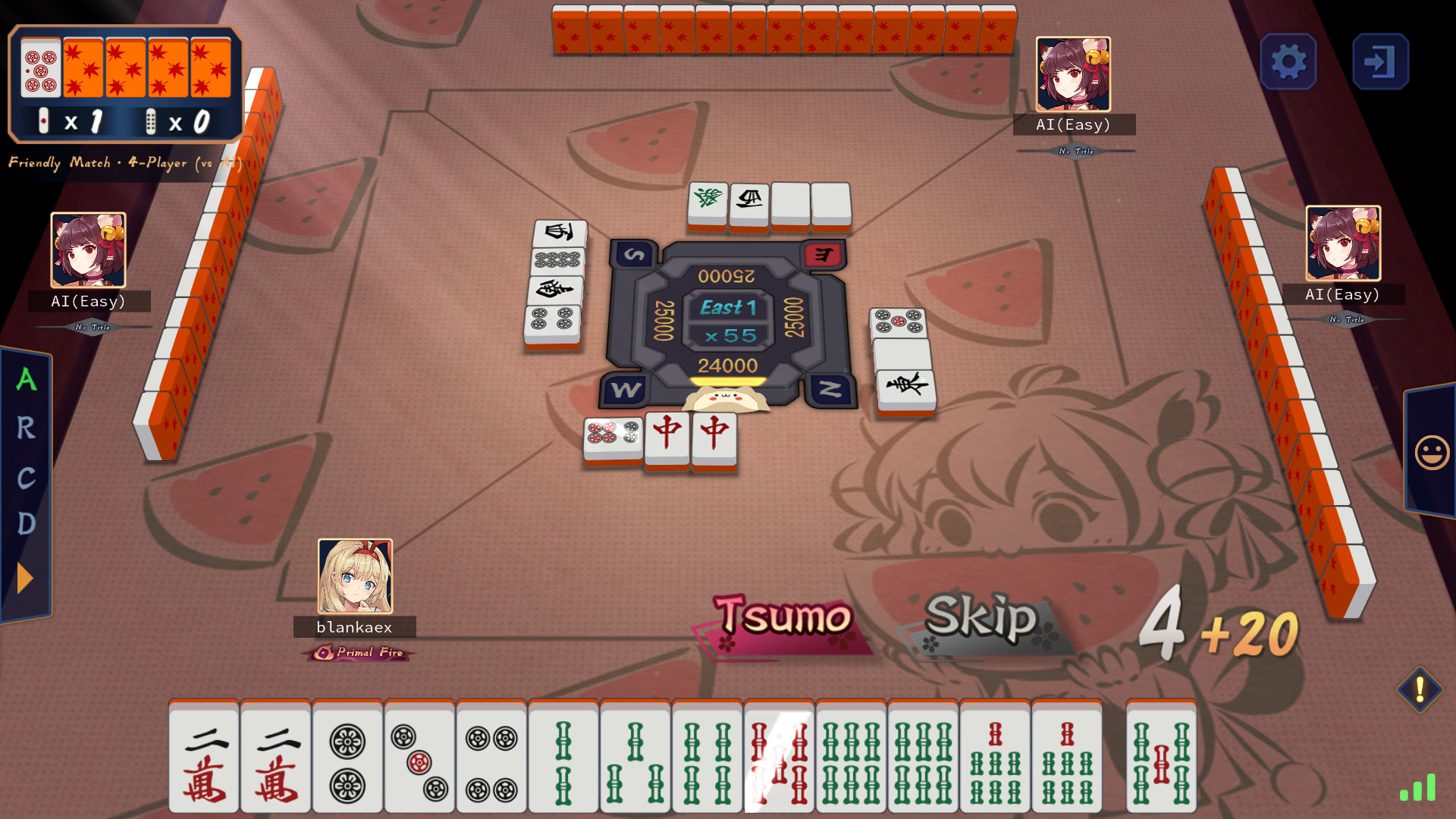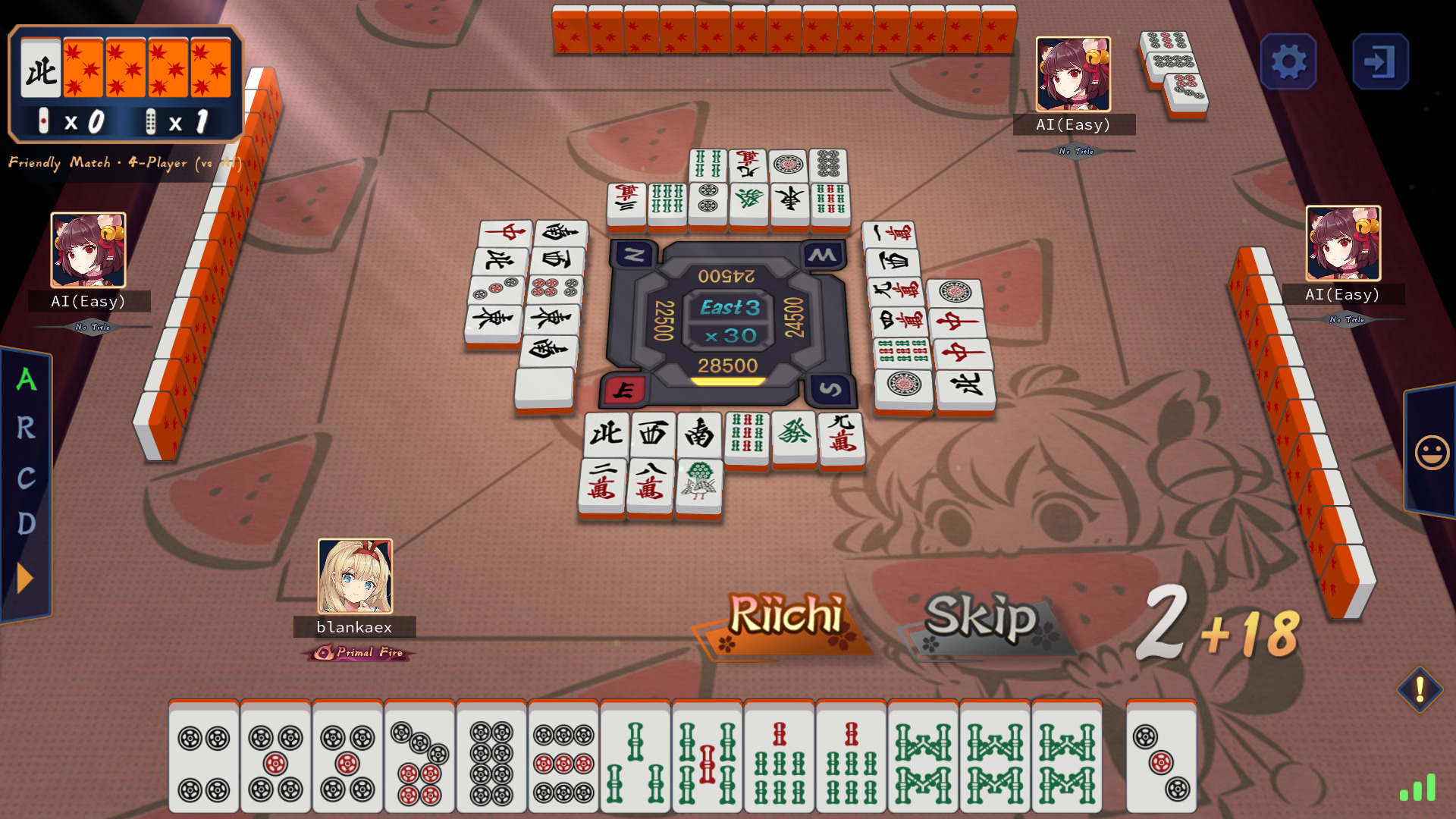Gameplay Loop
Riichi Mahjong is played with four players. Each player is dealt 13 tiles and starts with 25,000 points. They take turns drawing and discarding a tile, in order to build a winning hand. When a player wins a hand, they earn points from the other players and a new hand begins.
4 or 8 hands are typically played per game. Standings are determined by the number of points each player has at the end of the game.

Tiles
The game is played with a set of tiles which can be divided into five main categories: manzu (characters), pinzu (dots), souzu (bamboos), suufuupai (winds), and sangenpai (dragons). There are 4 copies of each of the 34 unique tiles, giving a total of 136.
Manzu
Pinzu
Souzu
Suufuupai & Sangenpai
Building Hands
A winning hand must contain four mentsu (melds) and one toitsu (pair), for a total of 14 titles.
Mentsu and Toitsu
A mentsu is a group of three, and can be either a shuntsu (sequence) or a koutsu (triplet). Shuntsu must comprise only manzu, pinzu and souzu. They cannot wrap around 1 and 9, and they must be of the same suit. Koutsu and Toitsu must also be of the same suit.
Valid Mentsu
Invalid Mentsu
Naki
Instead of drawing a tile on your turn, you are also able to naki (call) an opponent’s discarded tile if you can use it to complete a mentsu.
If an opponent discards a tile you need to complete a shuntsu, you can call chii to steal that tile. You can only call chii on the player seated to your left.
If an opponent discards a tile you need to complete a koutsu, you can call pon to steal that tile. You can call pon on any player.
When you call a tile, it becomes your turn. You do not draw a new tile as you would normally—the tile you called effectively becomes your “draw”. You must discard a different tile, and play resumes from the player to your right.

Tenpai
Each player’s hand contains 13 tiles, but 14 are needed to win. Once you have built a hand such that a 14th tile would form a winning hand, you are considered to be in tenpai (ready). The tile(s) that you can win off are called your machi (waits).
Machi: 3-pin or 6-pin
Winning a Hand
Once you are in tenpai, you can obtain your winning tile by either drawing it, or by stealing another player’s discard.
If you draw your winning tile, you can declare tsumo to win the hand. All other players must pay you a number of points depending on your hand’s value.
If an opponent discards your winning tile, you can declare ron to steal it and win the hand. Only the player whose tile you called owes you points. You can call ron on any player.

Yaku
A yaku is a pattern or condition that your hand fulfills, not unlike poker hands. In addition to the four mentsu and one toitsu rule, a hand must also contain or meet at least one yaku for it to qualify as a winning hand. You cannot win off a hand that has no yaku, even if it has four mentsu and one toitsu.
There are dozens of yaku, many of which are very specific and/or rare. Memorising them all prior to playing your first game is unnecessary and ill-advised. Instead, it is recommended to gradually learn them as you play. To get started, you only need to remember the following four yaku: riichi, tanyao, toitoi and honitsu.
Riichi
The name of the game, and a bit of a unique yaku. If you are in tenpai and have not made a naki, you may declare riichi. Doing so will guarantee at least one yaku (riichi itself), which will make your hand a valid winning hand—even if it previously had no yaku.
Once you declare riichi, you are no longer able to change your hand. If the tile you draw on any subsequent turn is not your winning tile, you must discard that tile and may not exchange tiles for a more favourable hand. You are also not allowed to call chii or pon.
Declaring riichi is effectively a commitment to your current hand, and you are “locked-in” until you draw your winning tile or an opponent discards it. The return on this commitment is the aforementioned guaranteed yaku, as well as the potential for additional points. Riichi is the only yaku in the game you can qualify for by making a declaration.

Tanyao
The hand contains only 2-8 in manzu, pinzu or souzu. It may not contain 1 or 9 in any suit, and it may not contain suufuupai or sangenpai.
Machi: 4-pin or 7-pin
Toitoi
The hand contains only koutsu. It may not contain any shuntsu.
Machi: 7-pin or 4-sou
Honitsu
The hand contains only one suit. It may also contain suufuupai or sangenpai.
Machi: 2-pin or 5-pin
Getting Started
This guide has barely scratched the surface of Riichi Mahjong. Many rules which seasoned players may consider basic have been purposely omitted for the sake of simplicity, but you’re already ready to start playing. You should strive to learn all of the rules and yaku as you play, or after you get a feel for the game.
Start playing in a video game, as it will take care of a lot of the logistical work (setting up tiles, calculating points, etc.) for you. In the beginning, it’s okay to disregard your opponents’ discards entirely and focus solely on working towards one of the four yaku listed above. Each time you win (or lose) a hand, try to understand the situation and figure out the yaku so that you internalise them for next time.
Good luck, and have fun.
Additional Resources
| Riichi.Wiki | English Riichi Mahjong wiki. Great place to quickly look up jargon or read about specific rules, yaku and strategies in-depth. Formerly Arcturus Wiki. |
| Mahjong in 20 Minutes | Basically this guide but as a video, narrated by a cute v-tuber (Kusunoki Sio). Has English captions, but might still be a bit confusing due to the order she explains things and how oddly specific she gets about trivial edge cases. |
| Comprehensive Mahjong Guide | Three-and-a-half hour long comprehensive Riichi Mahjong video guide by HanaYoriUta. Probably the golden standard as far as English Riichi Mahjong video guides go. Recommended to watch after you’ve gotten more familiar with the game, or if you just have a lot of time to kill. |
| Riichi Book I | Written by Daina Chiba. Possibly the best English resource for intermediate Mahjong strategies. Definitely recommended reading, but don’t bother with it until you’re comfortable with the game and all of the rules/yaku. I happen to be a contributor too. |
| Mahjong Soul | Browser-based Riichi Mahjong platform, and by far the most popular place to play online. Entirely free to play, but has a gacha system for cosmetics. Also available on mobile. Playing on the Japan server is recommended if you can read tiles without English guides. |
| Hime Mahjong | Alternative online platform, available on Steam, iOS and Android. Has better gacha rates and more cosmetics than Mahjong Soul, but no English translation (yet) hence a smaller playerbase. English UI guide is available on Riichi.Wiki. |
| Tenhou | Japanese online Mahjong platform. Played by professionals. Tenhou ranking is widely considered an accurate reflection of player skill. Would highly recommend avoiding as a beginner, but you may find yourself wanting to test yourself in a more serious environment at some point in your journey. |